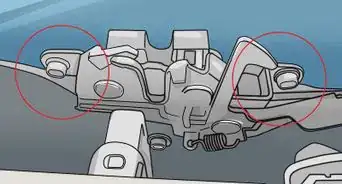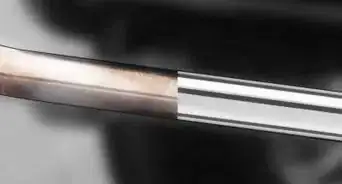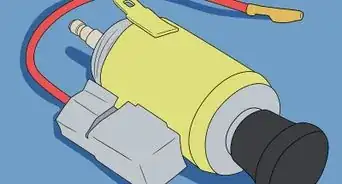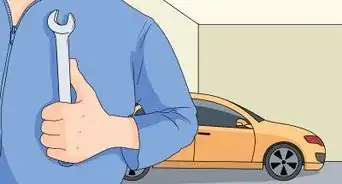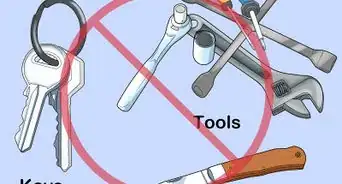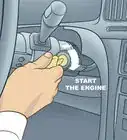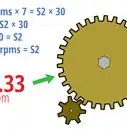This article was co-authored by Jason Shackelford. Jason Shackelford is the Owner of Stingray Auto Repair, a family owned and operated auto repair shop with locations in Seattle and Redmond, Washington. He has over 24 years of experience in auto repair and services, and every single technician on Jason’s team has more than 10 years of experience.
There are 11 references cited in this article, which can be found at the bottom of the page.
This article has been viewed 34,755 times.
The water in lead-acid car batteries evaporates over time, which can lead to reduced battery power and a shorter lifespan for your car’s battery. Checking your car battery’s water levels and topping them off when they get low is something simple you can do to get more life out of an old battery. Note that the only thing you should ever be refilling your car battery with is distilled or deionized water. Never add sulfuric acid because this leads to excessive corrosion.
Steps
Checking the Water Levels
-
1Put on protective eyewear and gloves. Always wear personal protective equipment when you’re working on your car battery. Choose eyewear that fully covers your eyes, such as safety glasses or goggles, and gloves that completely protect your hands, such as latex gloves or heavy-duty work gloves.[1]
- Keep in mind that only maintainable batteries are refillable. Check the warning labels on your battery to make sure it is not of the maintenance-free variety. If you see a label that says something like “DO NOT OPEN,” don’t attempt to refill your battery.
- Do this with your car turned off and be careful of hot parts if you recently ran the engine.
-
2Pry up the 2 cell port covers with a flat-head screwdriver if they are rectangular. Slide the flat edge of the screwdriver’s head under one of the covers and use the screwdriver like a lever to pop the cap off. Repeat this for the second rectangular cap.[2]
- There are 3 cell ports under each rectangular cover. These are the cell ports you check the water levels inside of.
Advertisement -
3Twist off the 6 cell port covers if they are round. Start at one end of the row of cell ports and twist the cap off of the first cell port by turning it counterclockwise until it comes loose. Repeat this for each of the remaining 5 cell port covers.[3]
- Car batteries that have round cell port covers have the same number and type of cell ports as those with rectangular caps. The only difference is the style of covers that the battery manufacturer uses.
-
4Use a damp rag to wipe down the battery around the cell ports. Soak a clean rag in water and wring out the excess moisture so it is just damp. Wipe the rag across the surface of the battery around the cell ports to clean off any dirt and grime that has accumulated around the caps.[4]
- Cleaning the surface of your battery helps inhibit corrosion of nearby metal parts and keeps dirt and debris from falling into the cell ports while you refill them.
- Doing this after you remove the cell port covers allows you to clean right up around the edges of the cell ports to get rid of any dust and dirt that has found its way under the edges of the caps.
-
5Look inside each cell to check if the metal plate is fully submerged in water. Examine each cell port closely and take note of whether there is an exposed metal plate in any of them. Go ahead and refill any cells where you see an exposed plate.[5]
- Note that the normal water level is about 3/4 of the way below the top of the cell. As long as you don’t see any exposed plates in the cells, you don’t have to refill your car battery just yet.
- Use a flashlight to see inside the cells if you don’t have enough natural light or if you’re finding it difficult to tell exactly where the water levels are.
Adding Water
-
1Make sure your car battery is fully charged before you add water. This is a best practice to ensure that you don’t overfill the cells. Run your car for about 30 minutes or use a charger to charge your battery all the way.[6]
- Keeping your lead-acid car battery charged also helps extend its lifespan.
- Make sure to turn your car off before you add water to the battery.
-
2Use only distilled or deionized water to refill your car battery. Purchase a bottle of distilled or deionized water to use for this. Never use tap water to refill your battery because it often contains minerals that can damage your battery.[7]
- Distilled and deionized water are both pure and contain no minerals, so that’s why they’re safe for batteries.
- Water is the only thing that your car battery consumes, so this is all you ever have to refill. Never attempt to add sulfuric acid to your battery or you’ll throw the gravity off, leading to rapid corrosion.
-
3Cover each exposed plate in water using a turkey baster or a small funnel. Use a turkey baster to suck up water from your bottle of distilled or deionized water and squeeze just enough into each battery cell with an exposed metal plate to cover the plate. Alternatively, stick a funnel into one the cell ports and slowly pour in enough water to just cover the exposed plate, then repeat this for each cell you’re filling.[8]
- Never fill the cells all the way to the rim or they can leak when you’re running your car and lead to corrosion. About 3/4 of the way down from the top of the cell is the ideal water level.
- If you accidentally overfill any of the cells, you can use a turkey baster to suck out the excess water and discard it.
-
4Replace the cell port covers. Snap each rectangular cap into place over 3 of the cell ports if your battery has these types of covers. Twist each round cap over 1 of the cell ports by placing it over the cell and turning it clockwise until it’s tight if your battery has these types of covers.[9]
- Be extra sure that each cap is on securely before you start up your car and hit the road. Try wiggling each cap to double-check that none of them are loose.
References
- ↑ https://www.crownbattery.com/news/watering-your-lead-acid-battery-the-basics
- ↑ https://images.homedepot-static.com/catalog/pdfImages/bb/bbdc5178-a8c3-4815-9eaa-b65509a1b713.pdf
- ↑ https://www.youtube.com/watch?v=y3BUHnykZvU&feature=youtu.be&t=113
- ↑ https://www.autoblog.com/2016/04/08/how-to-check-electrolyte-levels-in-your-battery/
- ↑ https://northeastbattery.com/water-battery-basics/
- ↑ https://antiquecars.info/how-to-check-old-classic-cars-battery-water-levels-refill/
- ↑ https://batteryuniversity.com/learn/article/water_loss_acid_stratification_and_surface_charge
- ↑ https://www.youtube.com/watch?v=Pesiwyi9uWk&feature=youtu.be&t=73
- ↑ https://www.autoblog.com/2016/04/08/how-to-check-electrolyte-levels-in-your-battery/
- ↑ https://www.popularmechanics.com/cars/car-technology/a26549/car-battery-how-to/
- ↑ https://batteryuniversity.com/learn/article/water_loss_acid_stratification_and_surface_charge
- ↑ https://www.youtube.com/watch?v=Pesiwyi9uWk&feature=youtu.be&t=90
- ↑ Jason Shackelford. Auto Technician. Expert Interview. 11 June 2019.
Expert Q&A
-
QuestionWhen removing a battery from a vehicle what cable should be removed first?
 Jason ShackelfordJason Shackelford is the Owner of Stingray Auto Repair, a family owned and operated auto repair shop with locations in Seattle and Redmond, Washington. He has over 24 years of experience in auto repair and services, and every single technician on Jason’s team has more than 10 years of experience.
Jason ShackelfordJason Shackelford is the Owner of Stingray Auto Repair, a family owned and operated auto repair shop with locations in Seattle and Redmond, Washington. He has over 24 years of experience in auto repair and services, and every single technician on Jason’s team has more than 10 years of experience.
Auto Technician Personally I remove the negative cable first. However, it usually doesn’t make a difference.
Personally I remove the negative cable first. However, it usually doesn’t make a difference.
Warnings
- Never add sulfuric acid to a car battery because this throws off the battery’s gravity and causes rapid corrosion.[11]⧼thumbs_response⧽
- Make sure to refill your car battery on a level plane, or else the water levels will be slanted and you won’t fill it correctly.[12]⧼thumbs_response⧽
- A battery home diagnosis is rather difficult and not very accurate. Most auto parts stores and some repair shops will usually test your battery at no charge.[13]⧼thumbs_response⧽
Things You’ll Need
- Protective eyewear
- Gloves
- Turkey baster or funnel
- Distilled or deionized water
- Flat-head screwdriver
- Flashlight (optional)















